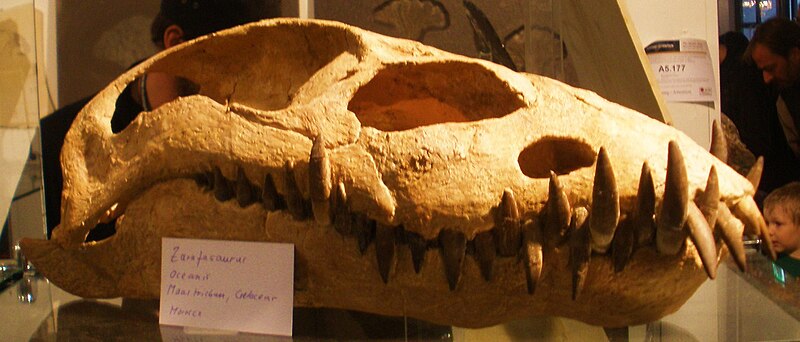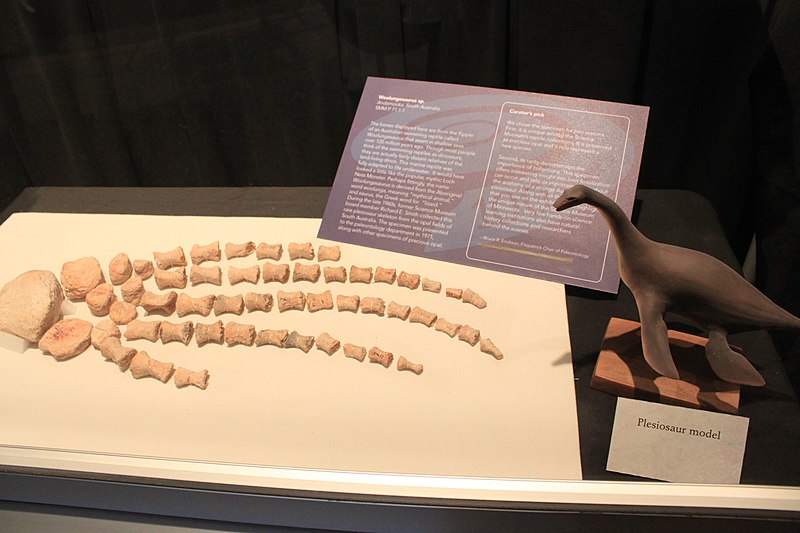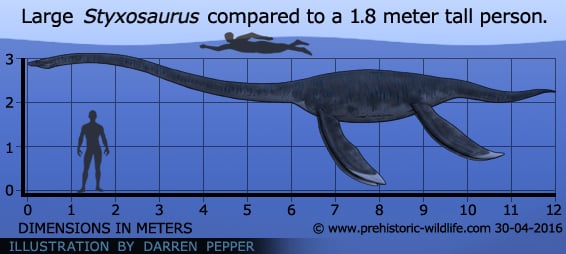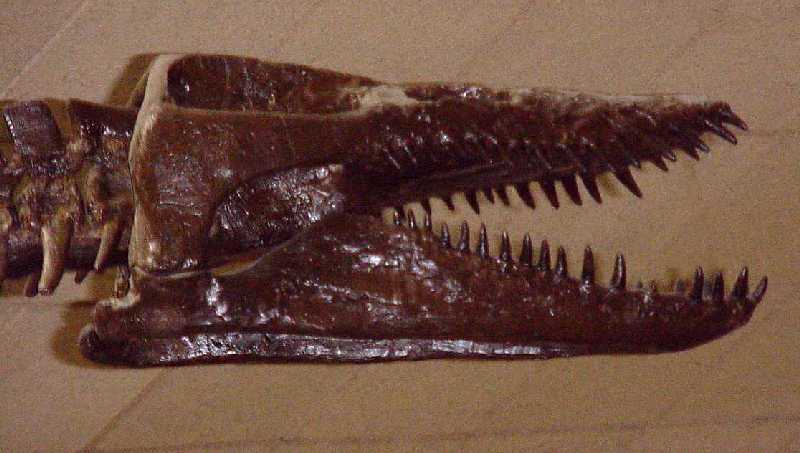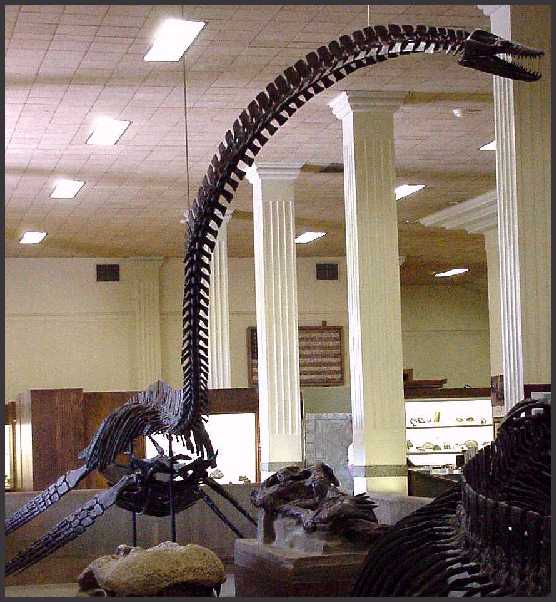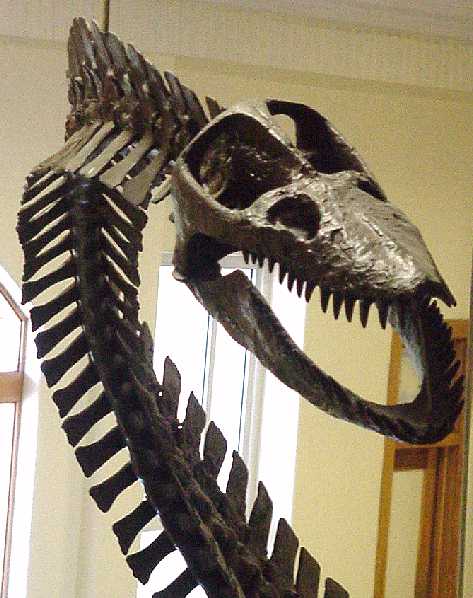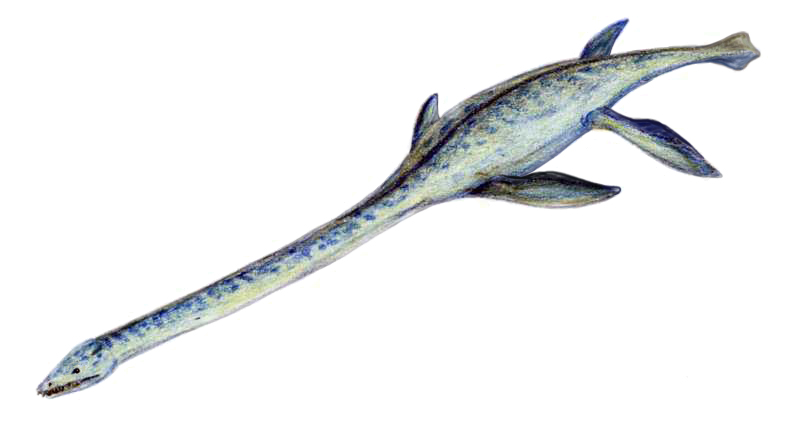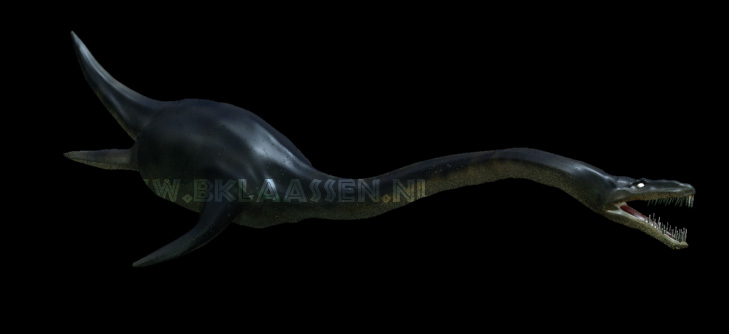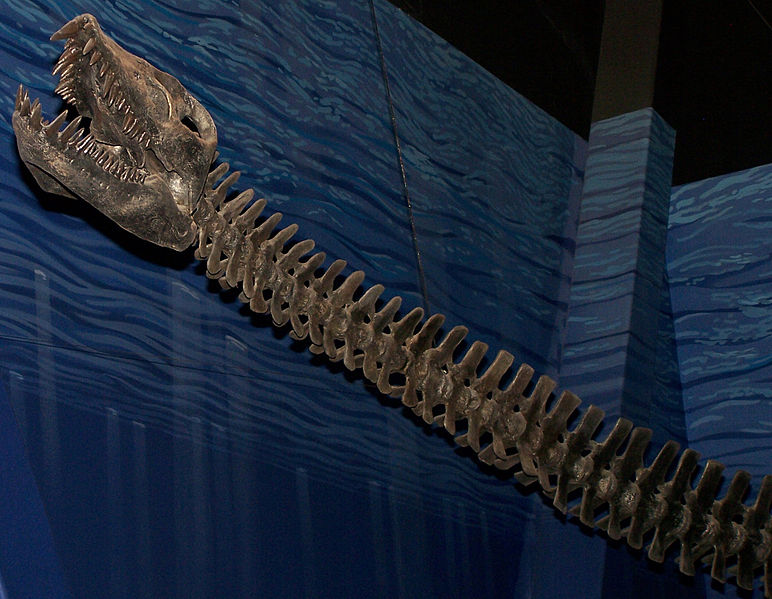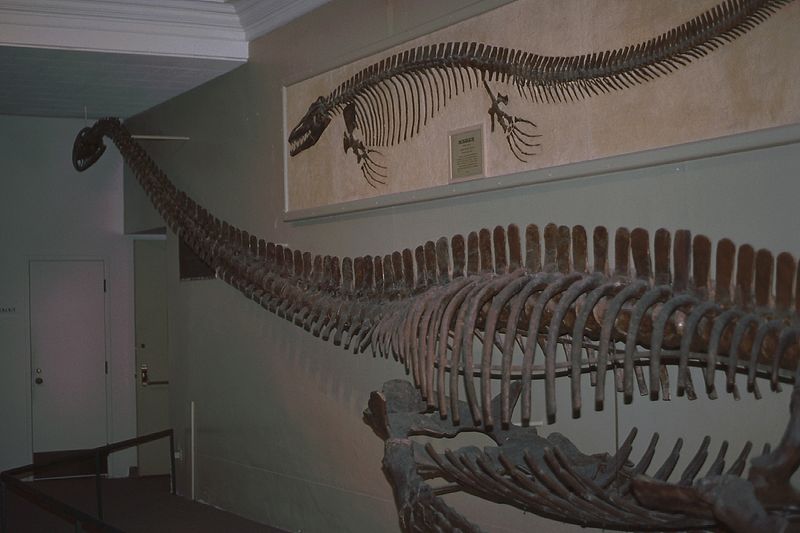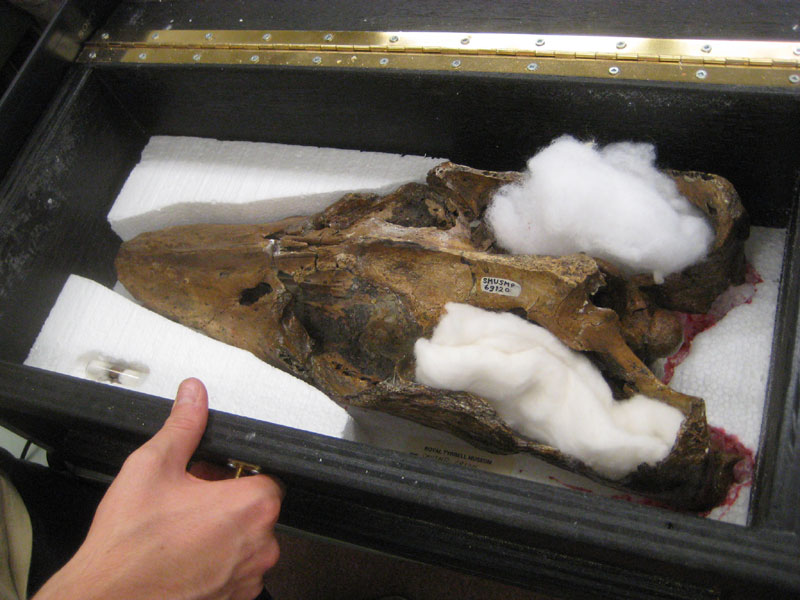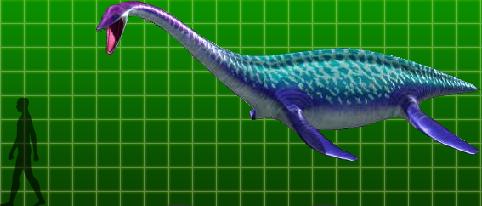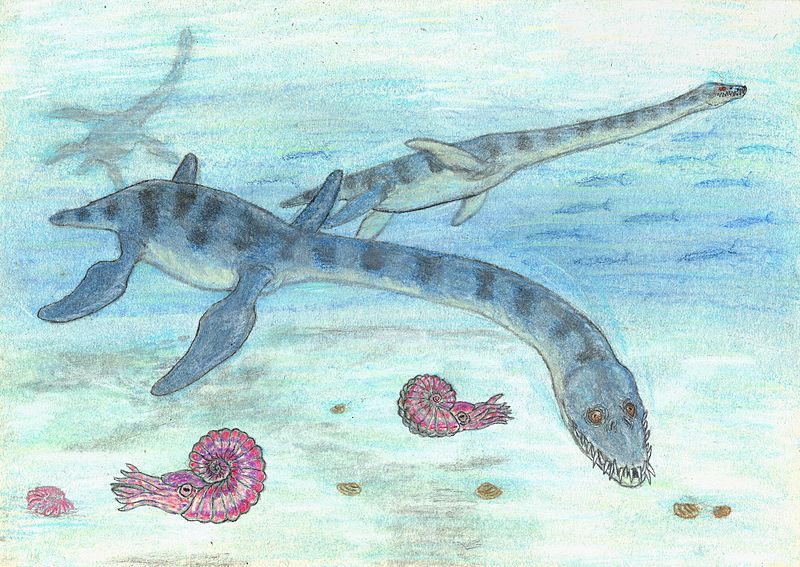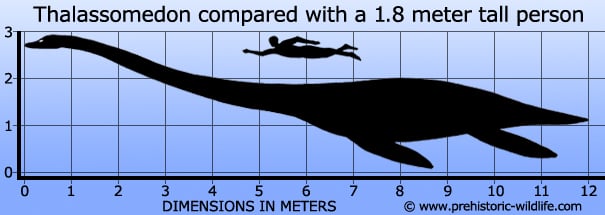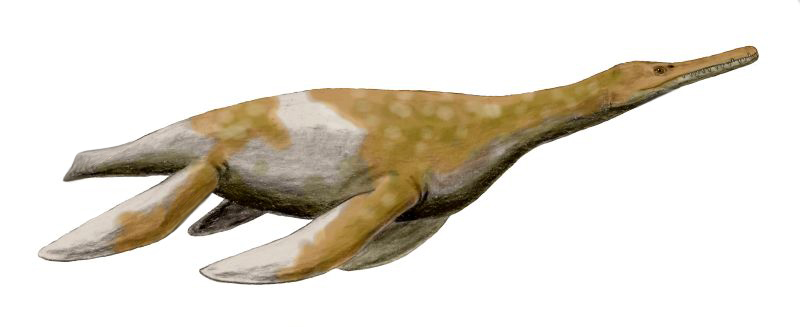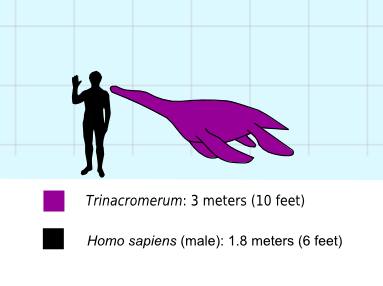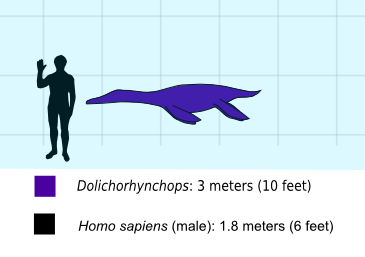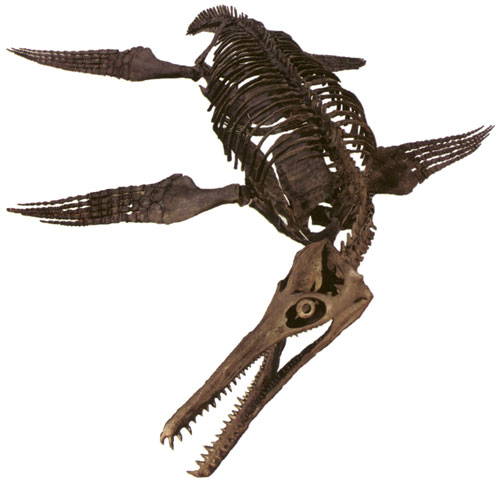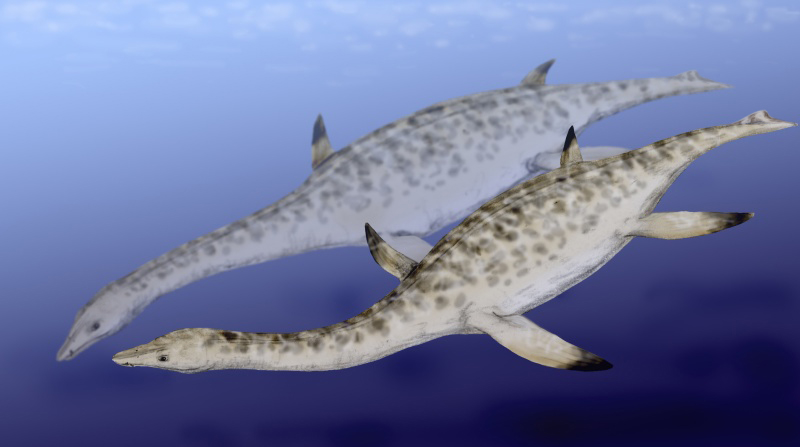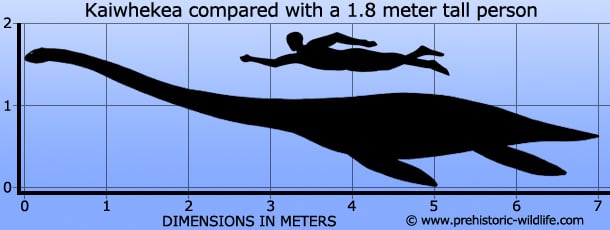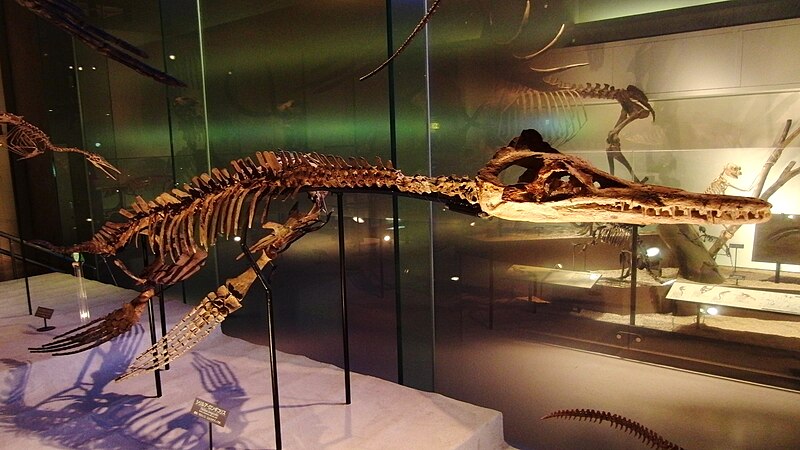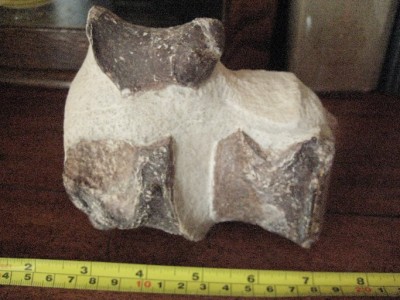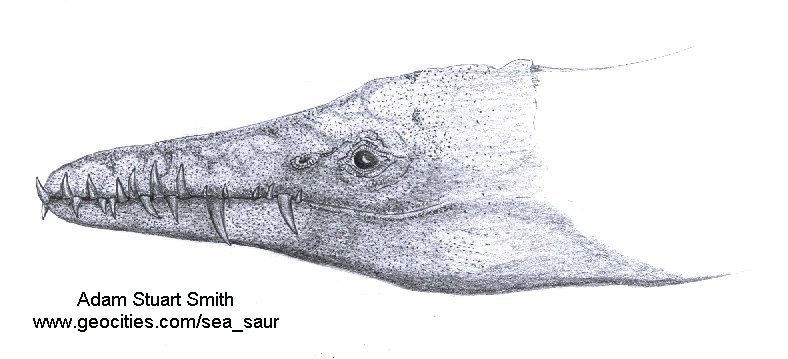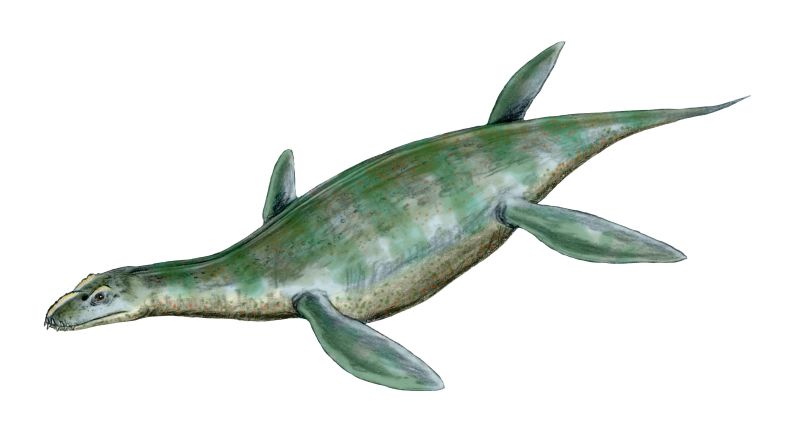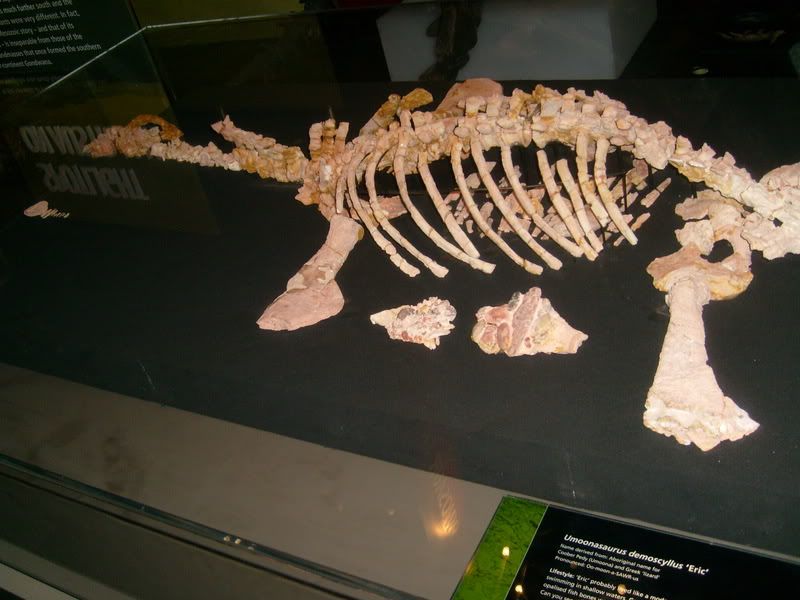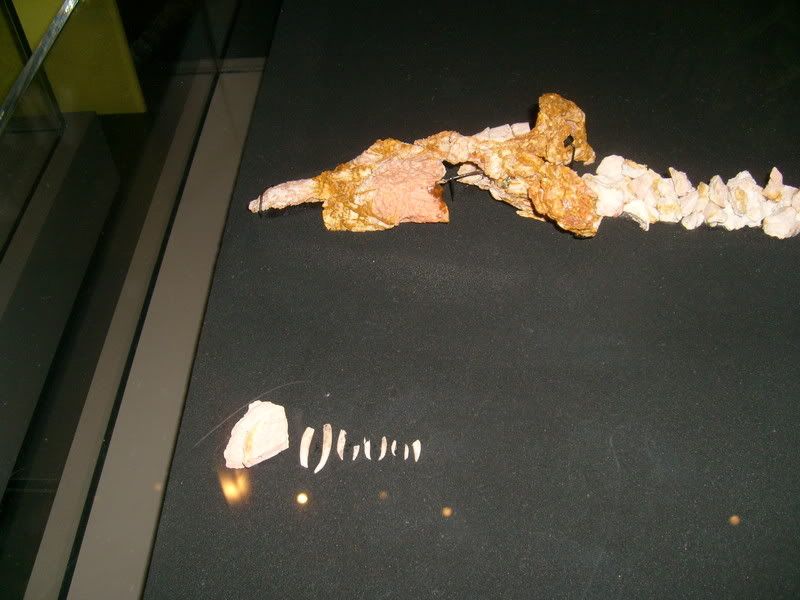[Recent Entries][Archive][Friends][User Info]
Below are the 20 most recent journal entries recorded in the "Сообщество, посвящённое ра" journal:| January 7th, 2014 | |
|---|---|
| 06:58 pm [industrialterro] [Link] |
Zarafasaura Zarafasaura is an extinct genus of elasmosaurid known from the Oulad Abdoun Basin of Morocco. Zarafasaura is known from the holotype OCP-DEK/GE 315, an articulated incomplete dorsoventrally crushed skull and mandible and from the paratype OCP-DEK/GE 456, a complete mandible. The holotype was collected in the Sidi Daoui area, from the Upper CIII level of the upper Cretaceous (latest Maastrichtian stage) Phosphates of Morocco. Zarafasaura was first named by Peggy Vincent, Nathalie Bardet, Xabier Pereda Suberbiola, Baâdi Bouya, Mbarek Amaghzaz and Saïd Meslouh in 2011 and the type species is Zarafasaura oceanis. The generic name is derived from zarafa (زرافة), Arabic for "giraffe" (it refers to the name given by the local population to the plesiosaurs found in the phosphates) and saurus, Greek for "lizard". The specific name is derived from oceanis, Latin for "daughter of the sea". Первый относительно полный скелет мелового плезиозавра обнаружили палеонтологи в марокканской фосфоритной шахте. Теперь ученые смогут лучше представить себе животный мир Африки накануне великого мел-палеогенового вымирания. Плезиозавры – довольно широко распространенная и хорошо изученная группа древних рептилий. Формально они не входят в состав отряда динозавров, но жили и вымерли в одно время с ужасными ящерами. "Околоящеры", как переводится с греческого название плезиозавров, были широко распространены в морях с триасового по конец мелового периода, а самые важные, ключевые их остатки находили в Австралии, Европе и Северной Америке. Представители африканского вида плезиозавров Zarafasaura oceanis жили в самом конце мелового периода, в маастрихтский век, и достигали примерно семи метров в длину. Реконструкции черепа этих животных, крепившегося к длинной "жирафьей" шее, показывают, что многочисленные длинные острые зубы при сведении челюстей смыкались между собой, образуя эффективную ловушку для добычи – рыбы и кальмаров. Своих жертв зарафазавры, вероятно, проглатывали целиком, поскольку их зубы не подходят для разделки добычи на более мелкие фрагменты. Родовое имя этого плезиозавра состоит из женской формы обычного для названий многих рептилий окончания –saurus, то есть ящер, и арабского слова zarafa – жирафа. Видовое восходит к древнегреческой мифологии и обозначает одну из дочерей Океана. Впервые этот вид был описан в 2011 году, но до последнего времени было известно лишь два образца этих животных – изолированный череп и хорошо сохранившаяся нижняя челюсть. И вот, наконец, почти полный скелет зарафазавры был найден в окрестностях марокканского города Уэд-Зем. "Из-за отсутствия посткраниального (то есть расположенного позади черепа) скелета предыдущим исследователям было трудно судить о том, как жил этот ящер", – рассказал соавтор исследования Уильям Вол из Вайомингского центра динозавров. "Открытия полных и сочлененных скелетов плезиозавров в Африке довольно редки, на сегодняшний день известно лишь несколько подобных образцов, – отметил Дин Ломакс, ведущий автор исследования и ассистент куратора палеонтологического подразделения британского музея Донкастера. – Многие образцы из Марокко очень фрагментарны и их идентификация обычно затруднена, если не невозможна". Новая находка, представляющая собой череп и значительную часть скелета, позволит ученым лучше понять, что представляли собой зарафазавры при жизни. "Самое главное, что в новом экземпляре сохранились многочисленные элементы вроде костей конечностей, позвонков, грудных и тазовых костей, благодаря которым теперь изолированные и разрозненные находки смогут быть идентифицированы, в случае их принадлежности к Zarafasaura", – приводит Sci-News.com слова Ломакса. "Мы надеемся, что новый вид плезиозавров оживит интерес к до сих пор не определенным образцам из Марокко, хранящимся во многих коллекциях", – поддержал его Вол. Ископаемые останки (1, 2, 3, 4, 5): Tags: Вымершие рептилии, Мел, диапсиды, завроптеригии, лепидозавроморфы, плезиозавроиды, плезиозавры, эласмозавриды |
| 06:35 pm [industrialterro] [Link] |
Woolungasaurus Woolungasaurus glendowerensis ('Glendower's Woolunga lizard', named after an Aboriginal mythical reptile, Persson 1960) is a plesiosaur, an extinct marine reptile, belonging to the Elasmosauridae. The type species Woolungasaurus glendowerensis, named by Per Ove Persson in 1960, is known from a partial skeleton, holotype QM F6890, (forty-six vertebrae, ribs, forearms, shoulder girdle and part of the rear limbs) unearthed from the Wallumbilla Formation (Albian, Lower Cretaceous) of the Richmond District, Queensland. The specific name refers to Glendower Station. Another find of undetermined species, consisting of twelve vertebrae, was unearthed from the Maree Formation (Cretaceous, of uncertain age) of Neale's River, near Lake Eyre, South Australia. In addition a skull from Yamborra Creek, near Maxwelltown, Queensland, described by Persson in 1982 has been referred to Woolungasaurus. Woolungasaurus appears to have been a typical elasmosaur, with forty sharp teeth and an estimated length of about 9.5 metres. Persson (1982) believes it to be closely related to the North American elasmosaur Hydralmosaurus. The genus was referred to Styxosaurus by Sven Sachs in 2004. Tags: Вымершие рептилии, Мел, диапсиды, завроптеригии, лепидозавроморфы, плезиозавроиды, плезиозавры, эласмозавриды |
| 04:26 pm [industrialterro] [Link] |
Styxosaurus Стиксозавр (Styxosaurus) — род вымерших рептилий из надотряда зауроптеригий, отряда плезиозавров, семейства эласмозаврид, живший с сантонского по кампанский век (так называемая «сенонская субэпоха») мелового периода, то есть примерно 85-70 миллионов лет назад. Этот ящер получил своё название в честь реки Стикс (др.-греч. Στύξ) из древнегреческой мифологии, которая отделяла царство мрачного Аида от живого мира. Часть слова «-завр» происходит от σαῦρος (sauros), что означает «ящерица». Типовой экземпляр был обнаружен в месторождении Хелл-Крик, в Логан Кантри, штат Канзас. Он и послужил материалом для названия, придуманного палеонтологом Сэмюэлем Полом Уэллесом, который описал этот род в 1943 году. В длину стиксозавр достигал 11-12 метров, весил 3-4 тонны, по размерам был сопоставим с автобусом. Как и у других эласмозаврид, у стиксозавра была очень длинная шея, занимавшая чуть ли не половину от общей длины ящера. Более того, стиксозавр являлся одной из самых длинношеих морских рептилий за всю историю Земли. Он также обладал большим, крепким туловищем. По мнению палеонтологов, длинная шея у стиксозавра была главным охотничьим приспособлением, позволяя ему врезаться в косяки рыб с минимальными затратами энергии. Широкое распространение получила теория о том, что такие длинношеие эласмозавриды, как стиксозавр, приближались к стае рыб снизу, пряча своё тело в мутной воде на глубине, так, что рыбы могли видеть только переднюю часть их головы. Такое поведение снижало возможность того, что атака ящера окажется заранее замеченной, и соответственно, увеличивало шанс успешной охоты. Стиксозавр обладал типичными для таких ящеров тонкими, острыми зубами, которые сцеплялись друг с другом, когда он закрывал пасть, что не оставляло жертве никаких шансов вырваться из этого капкана после того, как она оказывалась в зубах плотоядного. Его зубы были идеально приспособлены для того, чтобы хватать и удерживать добычу, но они были совершенно неспособны резать или пережёвывать её, поэтому ящеру приходилось заглатывать её целиком. Описание типового экземпляра вида Styxosaurus snowii было выполнено Сэмюэлем Уэнделлом Уиллистоном по целиком сохранившемуся черепу и двадцати шейным позвонкам. Другой весьма полный образец — SDSMT 451 (длиной около 11 метров) — был обнаружен около Ионы, места, расположенного в штате Южная Дакота, США, в 1945 году. Изначально этот вид был описан и назван как Alzadasaurus pembertoni (в честь города Альзада в штате Монтана, США, в окрестностях которого и были найдены останки этого вида) Уэллесом и Джеймсом Бампом в 1949-м и носил такое название вплоть до того момента, как палеонтолог Кен Карпентер признал его синонимом вышеупомянутого вида Styxosaurus snowii. В грудной полости этого скелета находилось свыше 200 (по некоторым данным, около 250) гастролитов — камней, которые ящер глотал с целью облегчить переваривание пищи. Любопытно, что в Школе Горнорудного дела скелет стиксозавра установлен так, что голова его смотрит вверх, выглядывая из воды, хотя в действительности этому ящеру принять такую позицию было физически невозможно. Несмотря на то, что большинство плотоядных для перемалывания пищи не используют гастролиты, их нашли почти во всех хорошо сохранившихся скелетах эласмозаврид. Представляется вероятным, что ящер использовал эти камни в качестве балласта, то есть для создания противодействия поднимающему эффекту воздуха в лёгких, который позволял бы ему плавать ближе ко дну, где он мог легче найти пищу. Но против этой версии говорят несколько фактов: первое — тот факт, что в одном из скелетов этого ящера, который был найден в сланцах Пьера в западном Канзасе, были обнаружены размолотые кости рыбы, перемешанные с гастролитами, а второе — известно, что вес гастролитов, обнаруженных в останках эласмозаврид, значительно меньше 1 % предполагаемой массы, которую имели эти животные при жизни. Таким образом, если в наши дни крокодилы и некоторые другие животные используют гастролиты в качестве балласта, вполне вероятно, что эласмозавры использовали их, так как их используют современные зерноядные птицы - как вспомогательное средство для перемалывания пищи, своеобразную «мельницу» (см. Хендерсон (2006), обратное утверждает Уингс (2004)). На сегодняшний день известно 4 коллекции останков стиксозавра, которые находятся в Канзасе и Южной Дакоте. Останки стиксозавра находят в формации Niobrara, в звене Upper Smoky Hill, с биостатиграфической точки зрения — в так называемой «Зоне гесперорниса», или Spinaptychus sternbergi. Вид Styxosaurus snowii принадлежит к семейству Elasmosauridae и является близким родственником Elasmosaurus platyurus, останки которого были обнаружены в Канзасе в 1867 году. Первый из описанных стиксозавров был первоначально назван Cimoliasaurus snowii Сэмюэлем Уиллистоном в 1890 году. Этот экземпляр включал целиком сохранившийся череп и более двадцати шейных позвонков (KUVP 1301), которые были найдены около Хелл-Крик Э. П. Вестом, палеонтологическим ассистентом университета Канзаса. Затем вид был переименован в Elasmosaurus snowii Уиллистоном в 1906-м, а впоследствии в Styxosaurus snowii Уэллесом в 1943 году. Другой вид, Styxosaurus browni, получил название в 1952 благодаря Уэллесу. Но, тем не менее, впоследствии он был признан синонимичным к гидралмозавру. Также среди известных синонимов стиксозавра нужно выделить такие виды, как Alzadasaurus kansasensis, Thalassiosaurus ischiadicus (греч. thalassa — «морской», «принадлежащий морю») и Thalassonomosaurus marshi (греч. nomo — «жить», «обитать»). Как и большинство других плезиозавров, стиксозавр, вероятно, питался белемнитами, кальмарами и рыбой (такими её разновидностями, как, к примеру, гилликус). Одной из главных особенностей челюстей стиксозавра было то, что они обладали мёртвой, блокирующей хваткой, что позволяло ящеру удерживать даже столь скользкую добычу. Репродукции (1, 2, 3, 4, 5, 6, 7): ( Read More ) Размеры тела в сравнении с человеком: Ископаемые останки (1, 2, 3, 4, 5): Tags: Вымершие рептилии, Мел, диапсиды, завроптеригии, лепидозавроморфы, плезиозавроиды, плезиозавры, эласмозавриды |
| 04:13 pm [industrialterro] [Link] |
Morenosaurus Morenosaurus is an extinct genus of plesiosaur from the Cretaceous of what is now California. The type species is Morenosaurus stocki, first named by Samuel Welles in 1943, in honor of Dr. Chester Stock. The species was found by Robert Wallace and Arthur Drescher in the Panoche Hills region of Fresno County. The skeleton they found was fairly complete, and lacked only the head and parts of the neck and paddles. The skeleton was originally mounted at Caltech but is now in the Natural History Museum of Los Angeles County. Morenosaurus may have been similar to Elasmosaurus or Thallasomedon, but studies in the early 2000s indicated that the fossils were too scrappy to identify to the family level. Morenosaurus is not to be confused with the similarly named plesiosaur Muraenosaurus.
Tags: Вымершие рептилии, Мел, диапсиды, завроптеригии, лепидозавроморфы, плезиозавроиды, плезиозавры |
| January 2nd, 2014 | |
| 04:01 pm [industrialterro] [Link] |
Elasmosaurus Эласмозавр (Elasmosaurus — «ящер с тонкими пластинами») — гигантский плезиозавр позднего мелового периода (85—65 млн лет назад). Останки обнаружены на территории Канзаса (США), Росcии и Японии. Достигал в длину 15 метров, впервые был описан Эдвардом Копом в 1868 году. Своё название получил за плоские кости плечевого и тазового пояса. В длинной (до 8 м) шее эласмозавра было 72 позвонка — больше, чем у любого другого известного животного. Нижняя часть плечевого пояса и тазобедренные кости растянуты в широкие, похожие на тарелки, структуры, к которым крепятся мощные мышцы, управляющие ластами. Голова по сравнению с телом крошечная, но она снабжена очень широкой пастью, вооружённой острыми, похожими на шипы, зубами. Судя по содержимому желудка, эласмозавр мог ловить самых быстрых рыб того времени. Как и у других плезиозавроидов, длинная шея эласмозавра служила для того, чтобы он мог хватать проворных рыб, не передвигая слишком быстро своё тучное тело. Время от времени эласмозавры заплывали на мелководья. Здесь они погружались на дно и заглатывали небольшие гладкие камешки, которые способствовали размельчению пищи в желудке и служили в качестве балласта. В желудке одного эласмозавра учёные обнаружили более 250 таких голышей. Изучение этих камней показало, что в течение жизни эласмозавры преодолевали в океане тысячи километров, собирая гальку и голыши в различных частях морского побережья. Видимо, детёныши эласмозавров, как и ихтиозавров, рождались в море. Elasmosaurus (/iːˌlæzmɵˈsɔrəs/; from Greek ελασμος elasmos 'thin plate' (referring to thin plates in its pelvic girdle) + σαυρος sauros 'lizard') is a genus of plesiosaur with an extremely long neck that lived in the Late Cretaceous period (Campanian stage), 80.5 million years ago. Elasmosaurus was about 14 m (46 ft) in length and weighed over 2,000 kg (2.2 short tons), making it among the largest plesiosaurs. It differs from all other plesiosaurs by having six teeth per premaxilla (the bones at the tip of the snout) and 71 neck (cervical) vertebrae. The skull was relatively flat, with a number of long pointed teeth. The lower jaws were joined at the tip to a point between the fourth and fifth teeth. The neck vertebrae immediately following the skull were long and low, and had longitudinal lateral crests. Like most elasmosaurids, Elasmosaurus had around three pectoral vertebrae. The tail included at least 18 vertebrae. The pectoral girdle featured a long bar, not present in juveniles. The scapula had margins of approximately equal length for the joint with the coracoid and the articular surface for the upper arm. The anterior edge of the pelvic girdle was made up of three almost straight edges directed to the front and sides of the animal. The ischia, a pair of bones that formed the posterior part of the pelvis, were joined along their medial surfaces. The limbs of Elasmosaurus, like those of other plesiosaurs, were modified into approximately equally sized rigid paddles. Certain aspects of the anatomy of Elasmosaurus were fairly derived among elasmosaurids, and plesiosaurs in general. As noted, Elasmosaurus can be distinguished by its six premaxillary teeth and 71 cervical vertebrae. Primitively, plesiosaurs and most elasmosaurids had five teeth per premaxilla. Some elasmosaurids had more: Terminonatator had nine and Aristonectes had 10 to 13. In addition, most plesiosaurs had fewer than 60 cervical vertebrae. Aside from Elasmosaurus, plesiosaurs that exceeded 60 cervicals include Styxosaurus, Hydralmosaurus, and Thalassomedon. Elasmosaurus is the only known plesiosaur with more than 70 cervicals. However, it had roughly the same neck length as Thalassomedon because the latter has proportionally longer vertebrae. Elasmosaurus had more vertebrae than any known animal. The presence of the pectoral bar is also considered an advanced feature. The long, low axis centrum differs from the condition seen in most other plesiosaurs, which have centra that are either shorter in length than height, or about equidimensional. Styxosaurus and Hydralmosaurus also have the condition present in Elasmosaurus. Another unusual feature of Elasmosaurus is the relatively equal lengths of the margins of the scapula, as mentioned above. Most plesiosaurs had longer margins for articulation with the coracoid than for articulation with the upper arm. While numerous species of Elasmosaurus have been named since its discovery, a 1999 review by Ken Carpenter showed that only one, the type species Elasmosaurus platyurus, could be considered valid. Various other species assigned to the genus are either dubious or have been classified in other genera. For example, E. serpentinus has been reclassified as Hydralmosaurus, E. morgani as Libonectes, and E. snowii as Styxosaurus. By the early part of the Late Cretaceous, plesiosaurs have evolved (or have been reduced) into two distinct groups. Elasmosaurus is the type genus for one of these groups, the elasmosaurids which had extremely long necks with relatively short heads, in contrast to the polycotylids which had shorter necks and relatively larger heads. Late Cretaceous elasmosaurids from the Western Interior of North America have few features that separate them and are morphologically primitive. However, as noted above, Elasmosaurus and some others have some derived features. It has been suggested that Elasmosaurus was closely related to Hydralmosaurus and Styxosaurus due to these advanced features. Elasmosaurus platyurus was described in March, 1868 by Edward Drinker Cope from a fossil discovered and collected by Dr. Theophilus Turner, a military doctor, in western Kansas, USA. Although other specimens of elasmosaurs have been found in various locations in North America, Carpenter (1999) determined that Elasmosaurus platyurus was the only representative of the genus. When E. D. Cope received the specimen in early March, 1868, he had a pre-conceived idea of what it should look like, and mistakenly placed the head on the wrong end (i.e. the tail). In his defense, at the time he was an expert on lizards, which have a short neck and a long tail, and no one had ever seen a plesiosaur the size of Elasmosaurus. Although popular legend notes that it was Othniel Charles Marsh who pointed out the error, there is no factual justification for this account (see below). However, this event is often cited as one of the causes of their long-lasting and acrimonious rivalry, known as the Bone Wars. In fact, although Marsh personally collected at least one plesiosaur from Kansas, and had several more from Kansas in the Yale Peabody collection, he never published a single paper on them. Although Cope verbally announced the discovery of Elasmosaurus platyurus in March 1868, he did not publish the "preprint" of his erroneous reconstruction of Elasmosaurus until August 1869. While much smaller, long-necked plesiosaurs from the Jurassic of England were well known at the time, this was the first time anyone had ever seen a Cretaceous elasmosaur. Cope's reconstruction showed it to have a long sinuous tail like a lizard or a mosasaur. Note that while O.C. Marsh claimed to have pointed out Cope's error "20 years after the fact" in an 1890 newspaper article, it was actually Joseph Leidy who pointed out the problem in his Remarks on Elasmosaurus platyurus address at the Academy of Natural Sciences of Philadelphia meeting on March 8, 1870. Elasmosaurus fossils have been found in the Campanian-age Upper Cretaceous Pierre Shale of western Kansas. The Pierre Shale represents a period of marine deposition from the Western Interior Seaway, a shallow continental sea that submerged much of central North America during the Cretaceous. Like most plesiosaurs, Elasmosaurus was incapable of raising anything more than its head above the water as it is commonly depicted in art and media. The weight of its long neck placed the center of gravity behind the front flippers. Thus Elasmosaurus could only have raised its head and neck above the water if in shallow water, where it could rest its body on the bottom. The weight of the neck, the limited musculature, and the limited movement between the vertebrae would have prevented Elasmosaurus from raising its head and neck very high as well. Nevertheless one study found that the necks of elasmosaurs were capable of 75–177˚ of ventral movement, 87–155° of dorsal movement, and 94–176° of lateral movement, depending on the amount of tissue between the vertebrae. "Swan-like" S-shape neck postures which required more than 360° of vertical flexion were not possible. The head and shoulders of the Elasmosaurus most likely acted as a rudder. If the animal moved the anterior part of the body in a certain direction, it would cause the rest of the body to move in that direction. Thus, Elasmosaurus could not have swum in one direction while moving its head and neck either horizontally or vertically in a different direction. Elasmosaurus was a slow swimmer and may have stalked schools of fish. The long neck would allow Elasmosaurus to conceal itself below the school of fish. It then would have moved its head slowly and approached its prey from below. The eyes of the animal could have had stereoscopic vision, which would help it find small prey. Hunting from below would also have helped by silhouetting the prey in the sunlight while concealing Elasmosaurus in the dark waters below. Elasmosaurus probably ate small bony fish, belemnites (similar to squid), and ammonites (molluscs). It swallowed small stones to aid its digestion. Elasmosaurus is believed to have lived mostly in open ocean. The paddles of Elasmosaurus and other plesiosaurs are so rigid and specialized for swimming that they could not have come on land to lay eggs. Thus it most likely gave live birth to its young like modern sea snakes. While direct evidence of reproduction in Elasmosaurus is not yet known, the contemporaneous plesiosaur Polycotylus is known to have given birth to live young
Репродукции (1, 2, 3, 4, 5, 6, 7, 8, 9, 10, 11, 12, 13): ( Read More ) Размеры тела в сравнении с человеком: Ископаемые останки (1, 2, 3, 4): Tags: Вымершие рептилии, Мел, диапсиды, завроптеригии, лепидозавроморфы, плезиозавроиды, плезиозавры, эласмозавриды |
| December 31st, 2013 | |
| 05:39 pm [industrialterro] [Link] |
Mauisaurus Mauisaurus ("Maui reptile") is a genus of plesiosaur that lived during the Late Cretaceous period around 80 to 69 million years ago in what is now New Zealand. It was the largest plesiosaur, and perhaps the largest marine reptile in New Zealand waters at the time. Mauisaurus haasti is the only known species of the genus. A handful of specimens have been found, although only a few are well preserved and mostly complete. The only other established New Zealand plesiosaur, Tuarangisaurus keyesi, cannot be linked as a direct relative to Mauisaurus. Mauisaurus was similar to other plesiosaurs. It had a characteristically long neck, that grew up to 15 metres (49 ft) in length, more than half its total length. Mauisaurus' neck length makes it one of the top plesiosaurs with a large neck to body length ratio. In total, Mauisaurus grew to around 20 metres (66 ft) in length and was easily the largest plesiosaur in New Zealand waters. Like other plesiosaurs, it had a long slender body, with numerous vertebrae, allowing flexible movement. On its underside, Mauisaurus had two sets of large flippers. These aided in swimming at high speeds, but may have also allowed the plesiosaur to venture onto shorelines for short amounts of time. Mauisaurus was a carnivore, with sharp jagged teeth that would have been used to grip fish or squid. Mauisaurus remains have all been found in New Zealand's South Island, near Canterbury. Altogether, around seven Mauisaurus specimens have been found in the area, most in or around the Waipara River. One Mauisaurus fossil was even found battling a mosasaur from the New Zealand region. Mauisaurus gardneri was described in 1877, but was later found to be separate to Mauisaurus haasti and is now considered a nomen nudum. Mauisaurus gets its name from the New Zealand Māori mythological demigod, Māui. Māui is said to have pulled New Zealand up from the seabed using a fish hook, thus creating the country. Thus, Mauisaurus means "Māui reptile". Mauisaurus gets its scientific last name from its original finder, Julius Haast, who found the first Mauisaurus fossil in 1870. The specimen was then first described in 1874. Mauisaurus is one of the few New Zealand prehistoric creatures, and so, has had much publicity in the country. On 1 October 1993, a set of stamps was released to the general public. Although it depicted many other dinosaurs and prehistoric life, Mauisaurus was featured hunting fish on the $1.20 stamp. Tags: Вымершие рептилии, Мел, диапсиды, завроптеригии, лепидозавроморфы, плезиозавроиды, плезиозавры, эласмозавриды |
| 05:25 pm [industrialterro] [Link] |
Libonectes Libonectes (meaning "southwest swimmer") is an extinct genus of sauropterygian reptile belonging to the plesiosaur order. It is known from a single fossil specimen found in the Britton Formation of Texas, dated to the lower Turonian stage of the late Cretaceous period. The animal was very similar to the related Thalassomedon, though the structure of the neck vertebrae were different, with taller neural spines and longer supporting processes of the bone, and its nostrils were slightly closer to the tip of the skull. The skull of the type specimen is the best preserved elasmosaurid skull known. The specimen consists of the skull and neck, as well as gastroliths found along with the fossil. A shoulder girdle and flipper were also found but were apparently discarded at some point in the past. The specimen was originally named Elasmosaurus morgani by Welles in 1949, but it was reclassified in its own genus by Carpenter in 1997. Tags: Вымершие рептилии, Мел, диапсиды, завроптеригии, лепидозавроморфы, плезиозавроиды, плезиозавры, эласмозавриды |
| 04:44 pm [industrialterro] [Link] |
Futabasaurus Futabasaurus is a genus of plesiosaur from the Late Cretaceous of Fukushima, Japan. Described and named in 2006, it was assigned to the family Elasmosauridae. The length was about 7 m, and the weight was about 3~4 tons. Long distance between the eye sockets and nostrils. Interclavicles and clavicles are fused and the anterior edge is bent. Relatively long upper arm. Slim thigh bones with a significant muscle scar. Futabasaurus suzukii was named from the family name of discover Suzuki, and futaba from the Futaba Group. The name "Futabasaurus" also appears in connection with a theropod dinosaur, also from the Late Cretaceous of Japan. However, this dinosaur was not officially named, so the dinosaur "Futabasaurus" is a nomen nudum when applied to this theropod. It is not the same as the plesiosaur named Futabasaurus. Futabasaurus is the first elasmosaurid found in Japan. The type species is F. suzukii. Many of the bones of the type specimen show apparent scavenging or predation by sharks. The first fossils of Futabasaurus were found in the Irimazawa Member of the Tamayama Formation, Futaba Group, Fukushima Prefecture, Japan, dating to the Inoceramus amakusensis zone of the early Santonian. The fossils were found by Tadashi Suzuki, a high school student around that time.
Размеры тела в сравнении с человеком: Tags: Вымершие рептилии, Мел, диапсиды, завроптеригии, лепидозавроморфы, плезиозавроиды, плезиозавры, эласмозавриды |
| 03:27 pm [industrialterro] [Link] |
Callawayasaurus Callawayasaurus is a genus of plesiosaur from the family Elasmosauridae. When the first Callawayasaurus fossil was first discovered by Samuel Paul Welles in 1962, he described it as Alzadasaurus colombiensis before it was moved into its current genus by Kenneth Carpenter in 1999. Callawayasaurus (Callaway) is named in honor of the paleontologist, Jack M. Callaway, editor of Ancient Marine Reptiles who, as Carpenter put it, "in his brief career as a vertebrate paleontologist, did much to improve our understanding of marine reptiles". The familiar suffix, -saurus comes from the Greek sauros (σαυρος), meaning "lizard" or "reptile". The first skull of Callawayasaurus to be found was 35 cm long, while the animal as a whole grew up to 8 m long. The nares of Callawayasaurus are elongated and positioned over the maxilla, which has 3-5 teeth. The neck contains 56 vertebrae which are relatively short compared to other elasmosaurids. Callawayasaurus fossils have no pectoral bars; in common with other plesiosaurs such as Terminonatator. They also lack postaxial accessory facets. Another nearly complete skeleton was found to be slightly more robust than the holotype specimen. This subtle change may indicate sexual dimorphism. The fist Callawayasaurus remains were found in the Paja Formation near Leiva, Boyaca Colombia. The species name for the type, "columbiensis", means "from Colombia." Callawayasaurus are known from the Aptian faunal stage of the early Cretaceous period, which extended from 125 to 112 million years ago. Ископаемые останки (1, 2, 3, 4, 5): Tags: Вымершие рептилии, Мел, диапсиды, завроптеригии, лепидозавроморфы, плезиозавроиды, плезиозавры, эласмозавриды |
| December 29th, 2013 | |
| 06:46 pm [industrialterro] [Link] |
Aristonectes Aristonectes (meaning 'best swimmer') is an extinct genus of plesiosaur from the Late Cretaceous of what is now South America and Antarctica. The type species is Aristonectes parvidens, first named by Cabrera in 1941. Aristonectes has been classified variously since the 1941 description, but a 2003 review of plesiosaurs conducted by Gasparini et al. found that Aristonectes was most closely related to elasmosaurid plesiosaurs like Elasmosaurus. A similar plesiosaur, Morturneria, may be a junior synonym of Aristonectes, the study found. Aristonectes has been recently placed within its own family, along with Tatenectes, Kaiwhekea, and Kimmerosaurus, by O'Keefe and Street (2009). Aristonectids are the sister family of the polycotylid cryptoclidoids. Аристонект (Aristonectes parvidens) — описан Х. Кабрерой в 1941 году из маастрихта Аргентины (Чубут в Патагонии). Это первый из описанных аргентинских плезиозавров. Известен разрушенный череп, позвонки и кости левого переднего ласта. Череп низкий, широкий, с огромным количеством (45 пар на верхней челюсти и 58 на нижней) ячеек мелких зубов. Длина черепа около 73 см. Длина шеи около 2 метров, около 30 шейных позвонков, общая длина доходила до 7—8 метров. The Aristonectidae is a taxonomic family of poorly known plesiosaurs from the Jurassic and Cretaceous periods. They are closely related to polycotylid plesiosaurs. The family is made up of Tatenectes, Kimmerosaurus, Aristonectes, and Kaiwhekea. This group was formerly known as the Cimoliasauridae, but since Cimoliasaurus is indeterminate and quite possibly elasmosaurid, this replacement name was erected. Tatenectes and Kimmerosaurus represent an earlier Oxfordian Jurassic radiation from Laurasia, while Aristonectes and Kaiwhekea represent a later Cretaceous radiation from Gondwana. Aristonectidae were characterized by a relatively larger head and shorter neck than the Plesiosauridae and Elasmosauridae. Teeth resemble those of the Plesiosauridae. The group is known only from scanty and fragmentary remains. The formal diagnosis of the clade is that they possess: A snout that is relatively long but unconstricted and wide anteriorly; A paroccipital process of the opisthotic that articulates only with the squamosal; Teeth that are small and relatively narrow (crown length < 1 cm); Number of premaxillary teeth is 7 or more; Number of maxillary teeth is greater than 30; Palate with a ventrally expanded boss projecting out of the plane of the palate between the posterior and anterior interpterygoid vacuity; Number of cervical vertebrae greater than 32; Cervical vertebrae much wider than long; Cervical vertebrae with poorly defined rims of articular surfaces; Marked dorso-ventral constriction of cervical centra on ventral midline (binocular-shaped); Neural arch and canal very small relative to centrum diameter.
Tags: Вымершие рептилии, Мел, аристонектиды, диапсиды, завроптеригии, лепидозавроморфы, плезиозавроиды, плезиозавры |
| 05:53 pm [industrialterro] [Link] |
Thalassomedon Талассомедон (Thalassomedon, от др.-греч. θᾰλασσομέδων «властелин моря») — род вымерших рептилий из надотряда зауроптеригий, отряда плезиозавров. Вероятнее всего, при своих размерах талассомедон был главным хищником своего времени. А вымер, возможно, в связи с появлением новых грозных плотоядных морских рептилий, таких, как тилозавр. Первое из известных открытий талассомедона датируется 1939 годом, когда палеонтолог Р. Л. Ланденберг обнаружил его голотип в США, в штате Колорадо. А свое название талассомедон получил в 1943 году, благодаря палеонтологу Сэмюэлу Полу Уэллесу. Талассомедон обитал на нашей планете в эпоху сеноманского яруса позднего мелового периода, в море, которое в ту эпоху разделяло на две части Северную Америку, примерно 95 миллионов лет назад. Помимо Колорадо, останки находят также в Монтане. Ближайшим родственником талассомедона был более известный эласмозавр, появившийся несколько позднее. Скелеты талассомедонов выставлены в шести американских палеонтологических музеях, в частности, в Американском музее Естественной истории в Нью-Йорке (голотип AMNH) и в Денверском музее Естественной истории (голотип DMNH). Известно, что черепа у скелетов, выставленных в трех из всех этих музеях — реконструкции, выполненные на основе разрушившихся окаменелостей. Талассомедон относится к эласмозавридам. Типовой вид — Thalassomedon haningtoni (часто встречаются ошибочные написания haringtoni, hanningtoni). В 1943-м Уэллес также описал род Alzadasaurus riggsi. В 1999 году палеонтолог Карпентер признал его синонимичным к Thalassomedon haningtoni. Другой род альзадазавра, A. colombiensis, был переименован в Callowayasaurus, остальные виды были признаны синонимичными по отношению к стиксозавру. При своей общей длине в 12 метров, талласомедон по меркам своего семейства был плезиозавром средних размеров, особенно в сравнении с гигантскими родственниками мауизаврами. При таких габаритах только его ласты были длиной от полутора до двух метров. В шее насчитывалось 62 позвонка. Длина черепа составляла 47 сантиметров, в то время как зубы составляли в длину 5 сантиметров. Весьма интересно, что при раскопках в желудках талассомедонов находят окаменевшие камни. Но если стиксозаврв использовали их для улучшения переваривания пищи (рыбы, которой они питались), то талассомедоны, вероятнее всего, использовали их только как балласт. Elasmosauridae was a family of plesiosaurs. They had the longest necks of the plesiosaurs and survived from the Late Triassic to the end of the Cretaceous. They had a diet of fish and shelless cephalopods. The earliest elasmosaurids were small, about 3 m (9.8 ft). At the end of the Cretaceous, elasmosaurids grew as large as 14 m (46 ft), such as Elasmosaurus. Their necks were the longest of all the plesiosaurs, with anywhere between 32 to 76 (Albertonectes) cervical vertebrae They weighed up to several tons. The family Elasmosauridae was erected by Cope in 1869, and anchored on the genus Elasmosaurus. Размеры тела в сравнении с человеком: Tags: Вымершие рептилии, Мел, диапсиды, завроптеригии, лепидозавроморфы, плезиозавроиды, плезиозавры, эласмозавриды |
| 04:23 pm [industrialterro] [Link] |
Polycotylus Polycotylus is a genus of plesiosaur within the family Polycotylidae. The type species is P. latippinis and was named by American paleontologist Edward Drinker Cope in 1869. Eleven other species have been identified. The name means 'much-cupped vertebrae', referring to the shape of the vertebrae. It lived in the seas of North America, Russia and Australia toward the end of the Cretaceous. One fossil preserves an adult with a single large fetus inside of it, indicating that Polycotylus gave live birth, an unusual adaptation among reptiles. Like all plesiosaurs, Polycotylus was a large marine reptile with a short tail, large flippers, and a broad body. It has a short neck and a long head, and was about 5 metres (16 ft) long. It has more neck vertebrae than other polycotylids, however. Polycotylus is thought to be a basal polycotylid because it has more vertebrae in its neck (a feature that links it with long-necked ancestors) and its humerus has a more primitive shape. The long ischia of the pelvis are a distinguishing feature of Polycotylus, as are thick teeth with striations on their surfaces, a narrow pterygoid bone on the palate and a low sagittal crest on top of the skull. Edward Drinker Cope named Polycotylus from the Niobrara Formation in Kansas in 1869. The holotype bones from which he based his description were fragmentary, representing only a small portion of the skeleton. A more complete skeleton was later found in Kansas and was described in 1906. A nearly complete skeleton was found in 1949 from the Mooreville Chalk Formation in Alabama, but was not described until 2002. Unlike some better-known long-necked plesiosaurs like Plesiosaurus and Elasmosaurus, Polycotylus had a short neck. This led to it being classified as a pliosaur, a marine reptile within the superfamily Pliosauroidea, closely related to true plesiosaurs (which belong to the superfamily Plesiosauroidea). Polycotylus and other polycotylids superficially resemble pliosaurs like Liopleurodon and Peloneustes because they have short necks, large heads, and other proportions that differ from true plesiosaurs. As phylogenetic analyses became common in the last few decades, the classification of Polycotylus and other plesiosaurs have been revised. In 1997, it and other polycotylids were reassigned as close relatives of long-necked elasmosaurids. In a 2001 study, Polycotylus was classified as a derived cryptocleidoid plesiosaur closely related to Jurassic plesiosaurs like Cryptocleidus. In 2007, Polycotylus was placed in a new subfamily of polycotylids called Polycotylinae. Another newly-described polycotylid called Eopolycotylus from Glen Canyon, Utah, was found to be the closest relative of Polycotylus. A fossil of P. latippinis catalogued LACM 129639 includes an adult individual with a single fetus inside it. LACM 129639 was found in Kansas during the 1980s and was in storage at the Natural History Museum of Los Angeles County until it was described in 2011. The length of the fetus is around 40 percent of the length of the mother. Gestation was probably two thirds complete based on what is known of the fetal development of related nothosaurs. This fossil suggests that Polycotylus was viviparous, giving live birth (as opposed to laying eggs). Vivipary, or live birth, may have been the most common form of reproduction in plesiosaurs, as they would have had difficulty laying eggs on land. Their bodies are not adapted to movement on land, and paleontologists have long hypothesized that they must have given birth in water. Other marine reptiles such as ichthyosaurs also gave live birth, but LACM 129639 was the first direct evidence of vivipary in plesiosaurs. The lives of Polycotylus and other plesiosaurs were K-selected, meaning that few offspring were born to each individual but those that were born were cared for as they mature. Because it gave birth to a single large offspring, the mother Polycotylus probably gave it some form of parental care for it to survive. F. Robin O'Keefe, one of the describers of LACM 129639, suggested that the social lives of plesiosaurs were "more similar to those of modern dolphins than other reptiles." K-selected life-history strategies are also seen in mammals and some lizards, but are unusual among reptiles. ( Read More ) Tags: Вымершие рептилии, Мел, диапсиды, завроптеригии, лепидозавроморфы, плезиозавроиды, плезиозавры, поликотилиды |
| 02:58 pm [industrialterro] [Link] |
Trinacromerum Тринакромерум (Trinacromerum, от др.-греч. τριν- +ακρο- +μῆρον, «трёхвершинное бедро») — род вымерших рептилий из надотряда завроптергий, подотряда плезиозавров. Этот род включает два вида. Первый — Trinacromerum osborni, описанный палеонтологом Крагином в 1888 году. Второй — Trinacromerum bentonianum (типовой), открытый в 1908 году Уиллистоном. Синонимы — Ceraunosaurus brownorum, Dolichorhynchops kirki, Dolichorhynchops willistoni,Trinacromerum anonymum, Trinacromerum brownorum, Trinacromerum willistoni. Тринакромерум относится к семейству поликотилид и является близким родственником более известного долихоринхопса. В частности, он походил на него по своему внешнему виду и поведению. Тринакромерум — один из самых хорошо сохранившихся поликотилид. Этот ящер являлся плезиозавром, несмотря на то, что шея у него, была укороченной. Его челюсти были удлинены и усеяны похожими на иглы зубами. Тело было устремлено вперед. Тринакромерум был рыбо- и плотоядным ящером. Его быстрота и маневренность помогали ему с успехом охотиться. Тем не менее, он, скорее всего, часто становился жертвой значительно более крупных плиозавров, таких, как брахаухениус, обитавших в тех же водах. Развивать высокую скорость тринакромеруму позволяли длинные плавники. Любопытно, что биолог Ричард Элли, описал внешний вид этого ящера, как похожий на «Пингвина с четырьмя плавниками». Это пресмыкающееся обитало на нашей планете в эпоху позднего мелового периода, примерно 90 миллионов лет назад (сеноманский — туронский ярусы), в мелководных морях, на территории которых сейчас расположен североамериканский материк (Канада — провинция Манитоба, США — Колорадо, Канзас, Техас и Юта). Это было время, когда последние плиозавры боролись за жизнь с более приспособленными к окружающей среде мозазаврами. Тринакромерум достигал 3-ёх метровой длины и веса в 1000 фунтов. Размеры тела в сравнении с человеком: Ископаемые останки (1, 2, 3, 4, 5): Tags: Вымершие рептилии, Мел, диапсиды, завроптеригии, лепидозавроморфы, плезиозавроиды, плезиозавры, поликотилиды |
| 01:53 pm [industrialterro] [Link] |
Dolichorhynchops Dolichorhynchops is an extinct genus of polycotylid plesiosaur from the Late Cretaceous (early Turonian to late Campanian stage) of North America, containing three species, D. osborni, D. herschelensis and D. tropicensis. Dolichorhynchops was an oceangoing prehistoric reptile. Its Greek generic name means "long-nosed eye," perhaps because its eyes seem placed rather far forward on its lengthy snout. The holotype specimen of Dolichorhynchops osborni was discovered in the upper Smoky Hill Chalk Logan County, Kansas, by George F. Sternberg, as a teenager, in around 1900. The remains were collected by him and his father, Charles H. Sternberg, and then sold to the University of Kansas (Lawrence, Kansas). KUVP 1300 was prepared and mounted by H.T. Martin under the supervision of Dr. Samuel Wendell Williston, who described and named it in 1902. A more detailed description and photographs were provided by Williston 1903). The specimen has been on display in the KU Museum of Natural History since that time. In 1918, Charles H. Sternberg found a large mosasaur, Tylosaurus, with the remains of a plesiosaur in its stomach. The mosasaur specimen is currently mounted in the United States National Museum (Smithsonian) and the plesiosaur remains are stored in the collections. Although these important specimens were briefly reported by Sternberg 1922, the information was lost to science until 2001. This specimen was rediscovered and described by Everhart 2004a. It is the basis for the story line in the 2007 National Geographic IMAX documentary Sea Monsters: A Prehistoric Adventure, and a book by the same name Everhart 2007. George Sternberg found a second, less complete specimen of D.osborni in 1926. In his effort to sell the specimen to a museum, Sternberg took detailed photographs of the skull. The specimen was eventually mounted in plaster and was acquired by the Harvard Museum of Comparative Zoology. MCZ 1064 was on display there until some time in the 1950s. This specimen was never completely described although the skull was figured by O'Keefe 2004. (See also Everhart 2004b) The specimen of D. osborni on exhibit at the Sternberg, FHSM VP-404 was found by Marion Bonner near Russell Springs in Logan County in the early 1950s. It is, perhaps, the most complete specimen of this species known. It is just under 10 feet in length. The skull was crushed flat but is in very good condition. This specimen was initially reported by Sternberg & Walker 1957, and then was the subject of a Masters thesis by Orville Bonner 1964. Note that it was described by Bonner as "Trinacromerum osborni" which was the accepted genus name at the time. Two very large specimens of a polycotylid plesiosaur (KUVP 40001 and 40002) were collected from the Pierre Shale of Wyoming and later reported on by Adams in her 1977 Masters thesis. Later (1997), she officially described (1997) as a new species of Trinacromerum (T. bonneri). Unknown to her at the time, Carpenter (1996) had revised the Polycotylidae and separated Dolichorhynchops from Trinacromerum. Thus the species would revert to Dolichorhynchops bonneri, but there is some question as to whether or not the specimens represent a separate species or just larger individuals of D. osborni. The question has yet to be resolved. Until recently, all known specimens of D. osborni in Kansas had been collected from the upper layers of the Smoky Hill Chalk (Campanian age). Everhart 2003 reported the first remains from the lower chalk (Late Coniacian-Santonian in age). In 2005, the remains of the earliest known D. osborni were discovered in the Fort Hays Limestone, Niobrara Formation in Jewell County, Kansas. This is the first record of a polycotylid plesiosaur in this formation. D. herschelensis was described as a new species by Tamaki Sato in 2005. It was discovered in the Bearpaw Formation of Saskatchewan, Canada, a Late Cretaceous (late Campanian to Maastrichtian) rock formation. The fossil was found close to the town of Herschel in south-western Saskatchewan, from which the species name is derived. The rock formation it was found in consists of sandstones, mudstones and shales laid down in the Western Interior Seaway, just before it began to revert to dry land. The type specimen of D. herschelensis was discovered in a disarticulated state (i.e. the bones were scattered about the discovery site). The skull, lower jaw, ribs, pelvis and shoulder blades were all recovered, but the spine was incomplete, so the exact number of vertebrae the living animal would have had is unknown. All four limbs are missing, with the exception of 9 small Phalanges (finger bones) and a small number of limb bones found close by which may belong to the animal in question. The specimen is believed to be an adult, due to the fusion of certain bones (it is generally assumed—not necessarily strictly correctly so—that other animals' skulls, much as humans', consist of dissociated bones interconnected by cartilage fontanelles that do not entirely close until full maturity). It is also believed to have been substantially smaller than its close relative, D. osborni, as some juvenile specimens of D. osborni are larger than the adult specimen of D. herschelensis. Assuming that only a few vertebrae are missing from the skeleton, the animal is estimated to be about 2.5 to 3 metres in length. The snout is long and thin, with numerous tooth sockets. However, very few of the thin, sharp teeth remain. D. tropicensis was first named by Rebecca Schmeisser McKean in 2011. The specific name is derived from the name of the Tropic Shale, in which the two specimens of D. tropicensis were found. It is known from the holotype MNA V10046, an almost complete, well-preserved skeleton including the most of the skull and from the referred specimen MNA V9431, fragmentary postcranial elements. It was collected by the Museum of Northern Arizona from a single locality within the Tropic Shale of Utah, dating to the early Turonian stage of the early Late Cretaceous, about 93.5-91 million years ago. D. tropicensis extends the known stratigraphic range for Dolichorhynchops back by approximately 7 million years. Previously three additional polycotylid taxa, Eopolycotylus, Palmulasaurus and Trinacromerum, have been named from the same formation, two of which are currently endemic to the Tropic Shale. Репродукции (1, 2, 3, 4, 5, 6, 7, 8, 9): ( Read More ) Размеры тела в сравнении с человеком: Ископаемые останки (1, 2, 3, 4, 5): Tags: Вымершие рептилии, Мел, диапсиды, завроптеригии, лепидозавроморфы, плезиозавроиды, плезиозавры, поликотилиды |
| December 25th, 2013 | |
| 07:38 pm [industrialterro] [Link] |
Nichollssaura Nichollssaura is an extinct genus of leptocleidid plesiosaur from the Early Cretaceous Boreal Sea of North America. The type species is N. borealis, found in the early Albian age Clearwater Formation near Fort McMurray, Alberta, Canada. Nichollssaura fills an approximate 40-million-year gap in the fossil record of North American plesiosaurs. The type specimen was discovered in one of Syncrude Canada Ltd.'s open-pit oilsand mines near Fort McMurray, Alberta, in 1994. The fossil is on display at the Royal Tyrrell Museum of Palaeontology, missing only the left forelimb and scapula, lost when the beast was discovered accidentally by 100-ton electric shovel operators Greg Fisher and Lorne Cundal. The fossil, named after paleontological curator Betsy Nicholls, originally was named Nichollsia borealis but Nichollsia was already in use (preoccupied) by a genus of isopods. Thus, the original authors proposed Nichollssaura as a replacement generic name in 2009. Tags: Вымершие рептилии, Мел, диапсиды, завроптеригии, лепидозавроморфы, лептоклейдиды, плезиозавроиды, плезиозавры |
| December 19th, 2013 | |
| 09:26 pm [industrialterro] [Link] |
Kaiwhekea Kaiwhekea is an extinct genus of plesiosaur from the Late Cretaceous (Maastrichtian age) of what is now New Zealand. The type species, Kaiwhekea katiki, was first described by Arthur Cruickshank and Ewan Fordyce in 2002. Kaiwhekea was approximately 7 metres long and lived around 69-70 million years ago. The single known specimen, found in the Katiki Formation, is nearly complete, and is on display at the Otago Museum in Dunedin, New Zealand. Kaiwhekea has been placed as an aristonectid plesiosaur close to Aristonectes (O'Keefe and Street, 2009). In 2010, Kaiwhekea was transferred to Leptocleididae. Цимолиазавры или кимолиазавры (Cimoliasauridae) — загадочная группа (в ранге семейства) меловых плезиозавров. Известны по крайне фрагментарным остаткам из меловых отложений преимущественно Южного полушария. Считается, что по длине шеи были промежуточны между плезиозаврами и плиозаврами. Современный диагноз группы включает наличие большого числа мелких игловидных зубов, а также присутствие позвонков особой формы (шейные позвонки «бинокулярной» формы, сплюснутые сверху вниз и со сжатием посередине). Собственно говоря, в основном по позвонкам группа и известна. Kaiwhekea katiki или «плезиозавр из Шаг Пойнт» — удивительный плезиозавр, почти полный скелет которого был описан в 2002 году из позднего мела (маастрихт) формации Катики на Южном острове Новой Зеландии. Череп длиной 62 см, очень высокий, с короткой мордой. Глаза очень крупные, направлены вперед. Зубы мелкие, пересекающиеся при закрытой пасти, многочисленные (43 пары на верхней челюсти, 42 на нижней). Шея длинная — 43 позвонка, но малоподвижная. Грудных позвонков 3, туловищных 19—20, крестцовых 3—4, хвостовых 25—30. Общая длина свыше 6 м. По-видимому, охотился на глубине, ориентируясь по зрению. Мелкие зубы всех цимолиазавров предполагают питание мелкой добычей (головоногие, ракообразные). Название Kaiwhekea на языке маори означает «пожиратель осьминогов». Сходный образ жизни ведет современный тюлень-крабоед. Зубы служили своеобразной «ловушкой» для мелких жертв. Аристонект, мортурнерия и Kaiwhekea обитали в достаточно холодных полярных морях. Предками цимолиозавров могли быть криптоклиды, обладавшие сходным строением зубной системы. Возможно, большинство находок плезиозавров из мела Южного полушария может принадлежать к этой группе. Размеры тела в сравнении с человеком:
Tags: Вымершие рептилии, Мел, диапсиды, завроптеригии, лепидозавроморфы, лептоклейдиды, плезиозавроиды, плезиозавры |
| 09:06 pm [industrialterro] [Link] |
Thililua Thililua is a genus of polycotylid plesiosaur, containing one species, T. longicollis. The name Thililua is derived from that of an ancient aquatic god from local Berber mythology; longicollis refers to the animal's long neck. Thililua has been found in Late Cretaceous (early Turonian) rocks in the High Atlas mountains of Morocco in north Africa. Thililua is the first Polycotylid plesiosaur discovered in Africa, and also the first discovered that lived at a subtropical latitude. In 2010, Thililua was transferred to Leptocleididae as a sister taxon to Nichollssaura. The type specimen of T. longicollis, which was described in 2003, consists of an almost complete skull and lower jaw, articulated with 37 vertebrae. Of these vertebrae, 30 were cervical (neck) vertebrae, which is an unusually high number compared to other Polycotylids, such as Dolichorhynchops, which had only 19 neck vertebrae, and Polycotylus, which had 26. It is believed to be an adult specimen, since some of the cranial sutures are very difficult to distinguish. Using comparisons with the head and neck length to body length ratio of a related genus, Dolichorhynchops, the estimated total length of Thililua was 5.5 to 6 metres. Tags: Вымершие рептилии, Мел, диапсиды, завроптеригии, лепидозавроморфы, лептоклейдиды, плезиозавроиды, плезиозавры |
| 08:53 pm [industrialterro] [Link] |
Edgarosaurus Edgarosaurus is a genus of polycotylid plesiosaur, containing one species, E. muddi. The type specimen was found in Early Cretaceous (late Albian) rocks in the state of Montana in the USA. At the time, this location was covered by part of the Western Interior Seaway.
Tags: Вымершие рептилии, Мел, диапсиды, завроптеригии, лепидозавроморфы, плезиозавроиды, плезиозавры, поликотилиды |
| 08:29 pm [industrialterro] [Link] |
Plesiopleurodon Плезиоплевродон (Plesiopleurodon) — плезиозавр-поликотилид позднемеловой эпохи. Описан К. Карпентером в 1996 году из раннего сеномана Вайоминга (Belle Fourche Shale). Известен полный череп с нижней челюстью, коракоид и серия шейных позвонков. Череп низкий, с довольно длинной мордой, поверхностно схож с черепом лиоплевродона (отсюда название — «близкий к лиоплевродону»). На длинном симфизе нижней челюсти 8 пар крупных зубов, круглых в поперечном сечении, с исчерченным основанием. Шейные рёбра с одной головкой, в отличие от лиоплевродона. Размеры мелкие — длина черепа 71 см, общая длина около 3 метров. Единственный вид — Plesiopleurodon wellesi. По-видимому, питался крупной рыбой и головоногими. Карликовый размер особей этого вида может свидетельствовать о какой-то особой пищевой специализации. Plesiopleurodon is an extinct genus of plesiosauroid from the Late Cretaceous of North America. It was named by Carpenter based upon a complete skull and lower jaws, neck vertebrae, and a right coracoid. It was collected from the Belle Fourche Shale (lower Cenomanian), in the Rattlesnake Hills of Wyoming. In naming the specimen, Carpenter (1996, p. 264) noted "Of all known pliosaurs, Plesiopleurodon wellesi most closely resembles Liopleurodon ferox from the Oxfordian of Europe, hence the generic reference." The species is characterized by a moderately long symphysis bearing 8 pairs of teeth, teeth that are nearly circular in cross-section and which are smooth on the outer surface (except near the base), ribs of the neck vertebrae being singled-headed (double-headed in Jurassic pliosaurs), and a long slender interpectoral bar on the coracoid. Polycotylidae — семейство короткошейных плезиозавров, живших в меловом периоде около 112-70 млн лет назад. Останки были найдены на всех континентах. With their short necks and large elongated heads, they resemble the pliosaurs, but closer phylogenetical studies indicate that they share many common features with the Plesiosauridae and Elasmosauridae. They have been found worldwide, with specimens reported from New Zealand, Australia, Japan, Morocco, the USA, Canada, the former states of the USSR and South America.
Tags: Вымершие рептилии, Мел, диапсиды, завроптеригии, лепидозавроморфы, плезиозавроиды, плезиозавры, поликотилиды |
| 08:04 pm [industrialterro] [Link] |
Umoonasaurus Umoonasaurus is an extinct genus of plesiosaur belonging to the family Leptocleididae. This genus lived approximately 115 million years ago (Aptian-Albian) in shallow seas covering parts of what is now Australia. It was a relatively small animal around 2.5 m (8 ft) long. An identifying trait of Umoonasaurus is three crest-ridges on its skull. Umoonasaurus is known from a relatively complete skeleton preserved as opal from Coober Pedy in South Australia. This specimen was prepared by Paul Willis at the Australian Museum, Sydney, and became the focus of a nationwide fundraising appeal coordinated by ABC TV's Quantum program. Останки двух новых видов древних морских рептилий, которые плавали в морях в районе современной Австралии около 115 млн. лет назад, обнаружили в среду австралийские ученые. Открытые новые виды получили названия Umoonasaurus и Opallionectes и принадлежат к группе плезиозавров. Руководитель исследования палеонтолог Бенжамин Кир из университета Аделаиды, сообщил, что к этой же группе ученые причисляют и огромных хищников времен юрского периода, которых называли "убийцами китов" (в шутку, естественно). Команда Бенжамина Кира изучила 30 образцов окаменелостей опалового оттенка, которые они взяли из отложений вокруг заброшенного шахтерского городка Кубер Педи на юге Австралии. Руководитель исследования сообщил, что морские длинношеие рептилии обитали в мелких водах внутреннего моря, когда-то существовавшего на месте Центральной Австралии. Когда континент был гораздо ближе к Антарктиде, 115 млн. лет назад большая часть территории Австралии оказалась затопленной холодной водой. Umoonasaurus достигал 2,4 метра в длину, а на его черепе находились три гребня. "Представьте себе компактное тело с четырьмя плавниками, достаточно длинной шеей, маленькой головой и коротким хвостом, напоминающее современных тюленей", - говорит профессор Гир. Первую рептилию сильно Opallionectes превосходили по размерам в 2 раза . Они достигали 6 метров в длину. Эти ящеры питались мелкой рыбой и кальмарами, которую они хватали многочисленными иголкообразными зубами. Tags: Вымершие рептилии, Мел, диапсиды, завроптеригии, лепидозавроморфы, лептоклейдиды, плезиозавроиды, плезиозавры |


